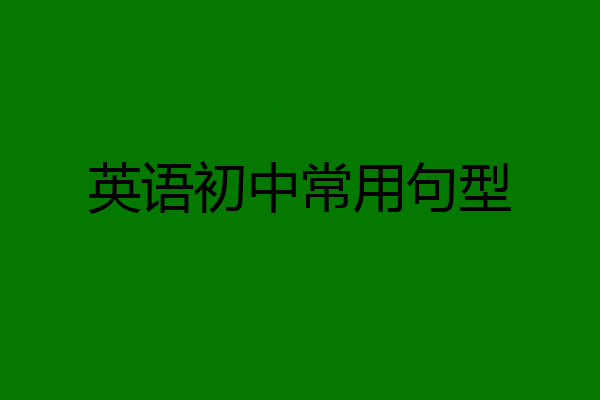
金德易BOSS
1. There be结构
there be结构和have has结构翻译成汉语都是“有”的意思,但含义不同。have (has)表示“某人拥有某物”,there be而结构表示“某人或某物存在于某地或某时”。
There are some apple trees in the garden.
We have some apple trees in the garden.
there be结构中的动词动词与后面的主语在数的方面保持一致。如果句中的主语是并列主语,即有两个或两个以上的人或物作主语,那么一般说来动词的数应与第一个主语的数保持一致。如:
There is a green apple and two oranges in the fruit bowl.
There are two oranges and a green apple in the fruit bowl.
2. I think he is very old.
(1)否定句
一些表示个看法的动词,如等引导宾语从句时,如果从句为否定句,那么否定形式应该表现在主句中,即否定这些动词本身。如:
I don’t think he is very old.
I didn’t think Wang Hai would enter for the high jump.
(2)反意疑问句
这些动词带有宾语从句构成反意疑问句时,根据主句主语的不同可分为两种情况:当主语是第一人称时,则缩略问句应与宾语从句的主、谓保持一致,但如果主句表现为否定为形式时,缩略问句要用肯定形式;当主句的主语是第二或第三人称时,缩略问句应该与主句保持一致。如:
I don’t think he has finished the work, has he?
You think my brother told a lie yesterday, don’t you?
3. That’s right. That’s all right. All right.
“That’s right.”表示“对、正确”。一般在对话中用于肯定对方的回答或表示赞同对方的说法。 “That’s all right.”是回答感谢话或道歉话的`用语,意思是“没关系,不用谢”,相当于“You are welcome”、“That’s OK”或“Not at all”“All right”一般用于同意别人的请求,是“好的、可以”的意思。如:
A: I think the correct answer is two. B: That’s right.
A: I am sorry I left your notebook at home. B: That’s all right.
4. He’s up there in the tree with Bill.
这句话的主语是“he”,“with Bill”不是主语,而是表示一种伴随状态,所以请注意谓语要和主语在数和人称称保持一致。一般在句子中我们经常用“with+名词”这种结构表示“有、带着或伴随着”的意思。如:
He went to the concert with me.=He and I went to the concert.
She answered me with a smile.
He went to sleep with the bedroom light on.
5. It’s time…
这一句型用来表示“是.....的时间了,该.....了”。一般有以下几种形式:
(1) It’s time to +动词原形
(2) It’s time for sb. +动词原形
(3) It’s time for +名词
如:It’s time to go to school.=It’s time for school.
It’s time for us to go to school.
6. What’s wrong with you?
这句话的意思是“你怎么了?”,既可表示问身体有什么不舒服,也可以表示问出了什么事,介词后还可以跟物品名称,表示问某样东西怎么了(是否出了什么毛病)。与其类似的句型还有:“What’s the matter with…? / What’s the trouble with…?”这三个句型在使用时要注意wrong是形容词,所以在它有前面不加冠词,而matter和trouble都是名词,在它们前面要加定冠词。如
What’s wrong with Bill?
What’s the matter (the trouble) with Bill?
7. They looked like saucers.
在本句中like是个介词,解释是“像.......”,常和动词be或look连用。请注意不要错把它当成动词“喜欢”。
8. You had better come early next time.
此句中的had better是一种习惯用法,意思是“最好…”成,一般用来表示向别人提建议或劝告.这一句经常可以与祈使句或带有情态动词should的句子进行替换.在使用had better时请注意以下几点: (1)它没有人称、时态和数量的变化。(2)它的后面只能跟动词原型。(3)它的否定式为had better not,后面同样只能跟动词原型在疑问句中,通常是把had提到主语之前。如
We had better not go fishing on such a windy day.
9. be + adj. + (for somebody) to do (something)
在此句型中谓语动词一般不用被动语态。同时请注意动词不定式都有动宾关系,因此如果不定式中的动词是不及物动词,那么它的后面一定加上适当的介词。
The problem is not very difficult for me to work out.
10. I hope… / I wish…
Hope与wish都可以解释为“希望”,但它们所表达的意思和用法都有所不同。在意思上Hope所表达的愿望是比较实际的,是可能实现的,而wish所表达的是不太可能实现的梦想,所以wish引导的宾语从句大多用虚拟的语气。在用法上它们的唏不完全相同,区别在于wish可以用于wish sb. to do,而hope没有这种用法。:,


坏坏的小幸福
句子 是 文章 的组成部分,只有组成了句子才有真正的意义。在英语 文章阅读 中,语法归根结底是为我们读懂文章而服务的,只要能够掌握基本的语法规律,无障碍的读懂复杂的句子,语法的任务就圆满的完成了。下面我就介绍5中初中英语句子机构常见句型:
一、Subject (主语) + Verb (谓语)
这种句型中的动词大多是不及物动词,所谓不及物动词,就是这种动词后不可以直接接宾语。常见的动词如:work, sing, swim, fish, jump, arrive, come, die, disappear, cry, happen等。如:
1) Li Ming works very hard.李明学习很努力。
2) The accident happened yesterday afternoon.事故是昨天下午发生的。
3)Spring is coming.
4) We have lived in the city for ten years.
二、Subject (主语) + Link. V(系动词) + Predicate(表语)
这种句型主要用来表示主语的特点、身份等。其系动词一般可分为下列两类:
(1)表示状态。这样的词有:be, look, seem, smell, taste, sound, keep等。如:
1) This kind of food tastes delicious.这种食物吃起来很可口。
2) He looked worried just now.刚才他看上去有些焦急。
(2)表示变化。这类系动词有:become, turn, get, grow, go等。如:
1) Spring comes. It is getting warmer and warmer.春天到了,天气变得越来越暖和。
2) The tree has grown much taller than before.这棵树比以前长得高多了。
三、Subject(主语) + Verb (谓语) + Object (宾语)
这种句型中的动词一般为及物动词, 所谓及物动词,就是这种动词后可以直接接宾语,其宾语通常由名词、代词、动词不定式、动名词或从句等来充当。例:
1) He took his bag and left.(名词) 他拿着书包离开了。
2) Li Lei always helps me when I have difficulties. (代词)当我遇到困难时,李雷总能给我帮助。
3) She plans to travel in the coming May Day.(不定式)她打算在即将到来的“五一”外出旅游。
4) I don’t know what I should do next. (从句)我不知道下一步该干什么。
注意:英语中的许多动词既是及物动词,又是不及物动词。
四、Subject(主语)+Verb(谓语)+ Indirect object(间接宾语)+Direct object (直接宾语)
这种句型中,直接宾语为主要宾语,表示动作是对谁做的或为谁做的,在句中不可或缺,常常由表示“物”的名词来充当;间接宾语也被称之为第二宾语,去掉之后,对整个句子的影响不大,多由指“人”的名词或代词承担。引导这类双宾语的常见动词有:buy, pass, lend, give, tell, teach, show, bring, send等。如:
1) Her father bought her a dictionary as a birthday present.她爸爸给她买了一本词典作为生日礼物。
2)The old man always tells the children stories about the heroes in the Long March.
老人经常给孩子们讲述长征途中那些英雄的 故事 。 上述句子还可以表达为:
1)Her father bought a dictionary for her as a birthday present.
2)The old man always tells stories about the heroes to the children in the Long March.
五、Subject(主语)+Verb (动词)+Object (宾语)+Complement(补语)
这种句型中的“宾语 + 补语”统称为“复合宾语”。宾语补足语的主要作用或者是补充、说明宾语的特点、身份等;或者表示让宾语去完成的动作等。担任补语的常常是名词、形容词、副词、介词 短语 、分词、动词不定式等。如:
1)You should keep the room clean and tidy. 你应该让屋子保持干净整洁。(形容词)
2) We made him our monitor.(名词)我们选他当班长。
3) His father told him not to play in the street.(不定式)他父亲告诉他不要在街上玩。
4)My father likes to watch the boys playing basketball.(现在分词)
5) Yesterday I had a picture taken with two Americans.(过去分词)
● 常见的动词有: tell, ask, advise, help, want, would like, order, force, allow等。
● 注意:动词have, make, let, see, hear, notice, feel, watch等后面所接的动词不定式作宾补时,不带to。如:
1) The boss made him do the work all day.老板让他整天做那项工作。
2) I heard her sing in the next room all the time last night.昨天晚上我听见她在隔壁唱了一个晚上。